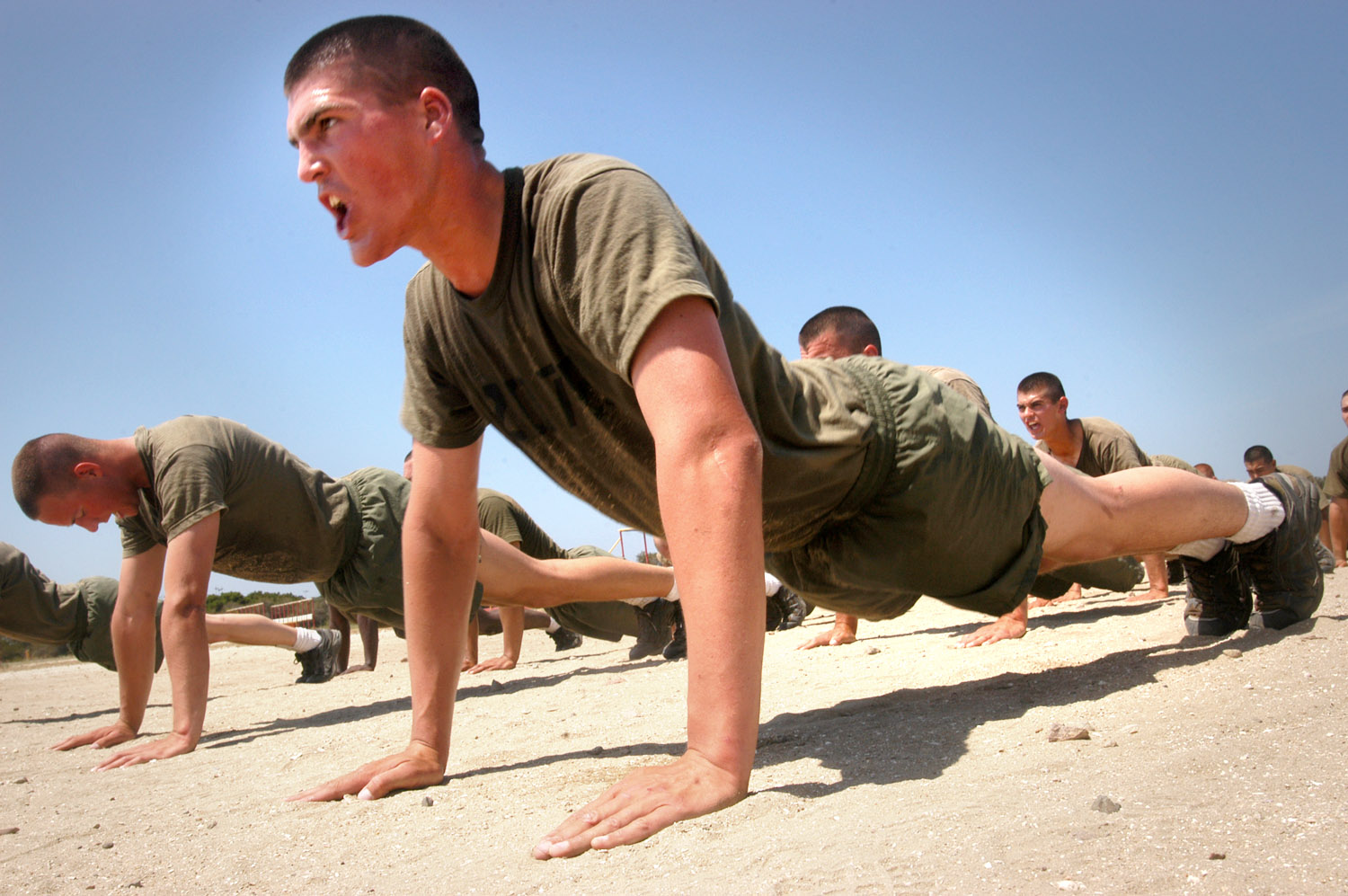Overlooked movements: Push-up variations & progressions

Welcome to the next movement in the “overlooked movement” series, where I apply my best efforts to remind you just how powerful and effective certain classic movements are. Last time it was the turn of the overhead press, today the spotlight falls on the ancient and classic bodyweight movement: the push-up!
First things first, the push-up has been a humanly used exercise movement pattern (calisthenic) for many a year. It was actually classified the “floor dip” once upon a time. However the current name “push-up” came into fruition in the early portion of the twentieth century.
With such a rich history, it’s no surprise the push-up is still very prevalent today. It is a commonly used fitness/endurance assessment tool, namely by the military. The military also use it as a punishment!
The push-up is often one of the very first exercise patterns we’re exposed to as children. I speak personally, I had been introduced to the concept well before entering my adolescent years.
“How many push-ups can you do?”……….
Is another phrase I hear often, although not quite as often as the hilarious………”How much can you bench, bro?”
Thankfully, guys haven’t seemed to attach as much of their masculine ego to their push-up performance as they have the bench press!
So what is a push-up?
Ask that to ten random people and you can likely expect ten different answers! Although suffice to say, the answers will undoubtedly follow a similar pattern of explanatory principles.
“A push-up is where you press the upper portion of your body up from the floor, whilst keeping your toes in contact with the floor” – is a possible, incredibly vague but to some degree, correct description of a push-up. Probably the type of answer you may hear from an untrained individual with minimal exercise knowledge.
Let’s identify and dissect a correct push-up!
Before we outline the specifics of technique, let’s outline the intended muscles that the push-up is designed to target.
They are:
- Pectoralis major
- Triceps brachi
- Anterior deltoids
- Rectus abdominus
Note: There was no inclusion of the hips or erector spinae/lumbar spine.
While I don’t place any emphasis on anyone’s maximal push-up rep claims, it’s important to highlight; high rep count/targets often encourage and create the demise of correct technique.
Quality > quantity
I learned this the hard way, but it really is true! Quality repetitions will do SO much more for your physical development than excessive quantity repetitions that are devoid of fully using the targeted muscles.
The push-up:

The above picture is a correct demonstration of optimal push-up technique.
Key points:
- Spine is neutral throughout (No flexion or extension/hyperextension)
- The entire body remains in a straight line throughout the movement (No “sag” of the knees or hips)
- Elbows remain in close to the sides of the body – (absolutely no “flare” allowed, by flaring you are simply placing most of the tension on a joint; the elbow joint! Not a muscle!)
- The abdominals and glutes are engaged, thus maintaining the “straight line” from head to toes. (The dis-engagement of the glutes will allow the hips to enter extension or “sag” – Dis-engagement of the abdominals will allow the lumbar spine to fall into extension or “sag”)
By adhering to the outlines above, we can ensure we keep the tension exactly where we want it: On the chest, triceps, abdominals and front deltoids.
Some helpful cues:
- Pull your belly in (Keeps abdominals engaged)
- Squeeze your buttocks (Glutes) – This will prevent the butt from “dropping” and allowing the hips to extend
- Think of your elbows as “posts” or “hinges” they are support for the movement, NOT the prime mover! Another analogy would be; think of a gate post, the post is your elbow, the gate is your upper torso. Only the gate moves.
How not to do a push-up:

As is obvious: The lumbar spine (lower back) is severely hyper-extended. We can safely observe; the abdominals have long since become dis-engaged.
Please realize this chap is in the military, where he commonly has a big, scary commando officer demanding he do hundreds of push-ups within a minute! (maybe I’m exaggerating slightly!)
Point being, he isn’t doing push-ups to build his upper body, rather they are a part of his duty. So technique and placement of tension is secondary.
Unless your sole purpose for doing exercises is purely rep count based or specific to a military direction, the above technique and you have zero business uniting! As many other fitness authors have pressed, sets of perfect push-ups beyond 30 reps are very rare – despite the influx of claimants being able to do “100+ within a minute”
Manipulating body angle to vary and progress your push-ups
When most people look to improve their push-up progress, they instantly think……”More reps! More reps!” I’ve fell victim to this many moons ago too. Once 15 repetitions per set can be achieved within the tempo guidelines prescribed, (I.E. Constant tension, no rest at the top of the movement and a controlled eccentric phase) and within the realms of optimal form as discussed above, then you are no longer going to experience further development in strength for this exercise. You will see an improvement in endurance however.
Which is fine if that’s your primary goal, but if you’re looking for better upper body development and strength, you’ll need to…….
Increase the resistance
Just like your bench pressing, curling or squatting. Once you can achieve your target rep goal on every work set, naturally you would bump the weight up 5 or 10 lbs. This is a form of progressive overload.
Progressively overloading the push-up:
Obviously increasing the load via external resistance is a feasible option, it is however quite awkward and rather impractical to start placing weight plates on your back, overloading backpacks or asking someone if they’d mind “pushing down on you for a moment”.
Not particularly practical. For most of us, anyway.
Manipulation of body angle is both more practical and superior!

In this standard push-up variation, you are lifting 64% of your total bodyweight. By the simple adjustment of body angle, we can alter that percentage significantly.

How about now? The percentage of total bodyweight as resistance at this angle is around 75% – a considerable increase.

And you can increase the height at which the feet are elevated to further force progression.

The ultimate push-up progression! The mother of all push-ups: The mighty handstand push-up! Your entire bodyweight is the resistance here.

Another contender for the title of “mother of all push-ups!” – The seriously impressive…….One arm push-up!
It comes down to this:
Taking your current push-up variation (that presents a challenge for you to achieve 3 sets of 15 repetitions with a smooth, controlled and continuous tempo) – whichever variant it may be.
To a more advanced variation of which forces you to handle a larger percentage of your bodyweight.
From this (potentially a push-up novice)
To this:

Moving on to:

Then:

And ultimately:

If you were to take your push-up capability from hypothetically a hands elevated beginner variation for 3 x 15 reps with 60 seconds rest between sets, to 3 x 15 HANDSTAND push-ups with the SAME structure, you will build unrecognizable upper body strength, mass and power. You will also have a bulletproof core!
It’s a promise, an assurance.
The purpose of this post is to highlight how underrated and under respected the true, strict push-up actually is. I’ve heard many people claim “push-ups are too easy” or “I’m a master of push-ups” when the sad reality is, these people can’t actually execute 20 good reps during which they keep all the target muscles engaged.
As I discussed extensively in this post, performance improvement always reigns supreme regarding achieving targets/goals.
A little bit of “humbling” is never lost on anyone. Allow this post to encourage you to embrace the humbling power of the push-up and it’s correct progression and execution.
Try using that simple progression yourself, once 15 reps can be achieved over 3 sets and a controlled rest period, increase the body angle and work up to 15 once again. Don’t worry if you only start with 5 reps per set once you upgrade the variation. If this is the case, you now have a GOAL to aim for. Always strive for at least one extra rep every workout and sure enough, you’ll get there!
Do you know anyone who can perform 3 sets of 15 strict handstand push-ups with 60 seconds rest?
If you do, I can tell you one thing about them myself………………
They will be one seriously strong and aesthetic BAD-ASS!!
Categories
JR @ Straight-Talking-Fitness View All
The 'brains' behind StraightTalkingFitness, a site all about discovery that leads to strength in all formats; fitness, mental, emotional and spiritual. Everything starts from within and projects outwards. Master the body, master anything and everything.


I can honestly say that I really enjoy push ups. I’m still trying out variations. I particularly enjoy the tricep push up and even more so as I couldn’t do one to start with. I often do push ups with my palms flat on the Bosu ball, flat side up, holding one leg up for 5 and then swapping.
That’s a good one. There are absolutely COUNTLESS variations/progressions with push ups. I particularly like them on rings/suspension straps. You can’t beat the degree of neuro-muscular activation you get!